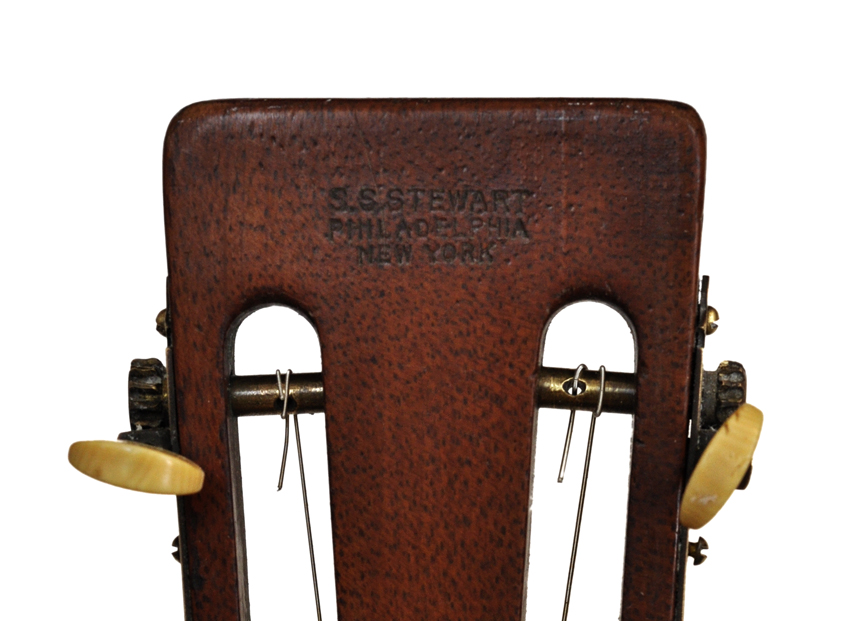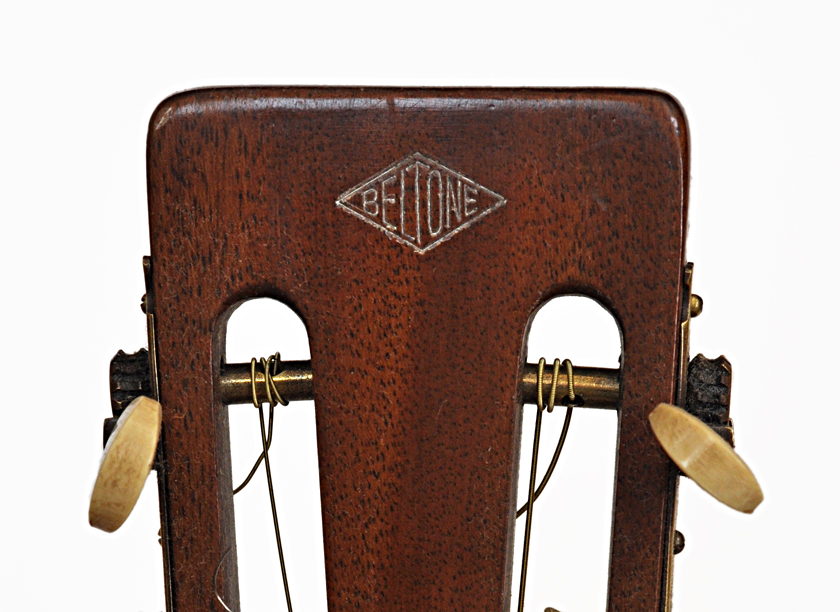A Stamp of
Approval
Labels and Stamps on C. F. Martin Guitars
C.F. Martin generally stamped their flat top guitars in three places, on
the neck block, on the inside of the back of the guitar, usually on
the center strip, and on the back of the headstock of guitars with cedar
or mahogany necks, or on the back of the guitar near the neck block on
guitars with ebonized necks and a number of early cedar neck guitars.
Early Martin guitars are stamped "C.F. Martin, New York" in all three
places. Beginning in 1867, the year Martin took on partners and
incorporated, the headstock stamp remained the same, but the inside
center strip stamp read "C.F. Martin & Co., New York", and neck
block stamp followed shortly thereafter. Even after Martin moved
to his new home in Cherry Hill, near Nazareth, Pennsylvania, his guitars
were sold through a representative in New York, so the New York stamp
remained. In 1898, after this sales arrangement dissolved, the
Martin company began stamping their guitars "C.F. Martin, Nazareth, PA."
In 1898, Martin also began numbering their guitars, beginning with
number 8000, an estimate of the number of instruments produced to that
date, stamping the serial numbers on the neck block below the "C. F.
Martin & Co." stamp.
The earliest Martins have paper labels,
sometimes accompanied by an outer back stamp as well. Martin also
occasionally used paper labels on instruments built for dealers, or
other special editions.
Finally, Martins supplied with coffin cases had a label glued to the
inside of the top of the case which indicated the style and size of the
guitar. Surprisingly, a fairly large percentage of the original
cases have survived with the labels still glued to the cases over a
century later. If the guitar were separated from the case,
however, there would be no designation of the style number and
size. In 1934, Martin began stamping the style name and size on the neck
block below the serial number. For a short time in 1900, Martin
also stamped the serial numbers of some guitars on the end of the
headstock.
Paper Labels
Several different labels appear on Martin Guitars with the 196 Hudson
Street New York address.

Heinrich Schatz, C.F.
Martin's friend and co-worker from Saxony to New York to Pennsylvania,
was listed as a partner for a short time in the late
New York period. When the Martin family moved from New York to
Pennsylvania, they sold inventory to Ludecus and Wolter for liquidation.
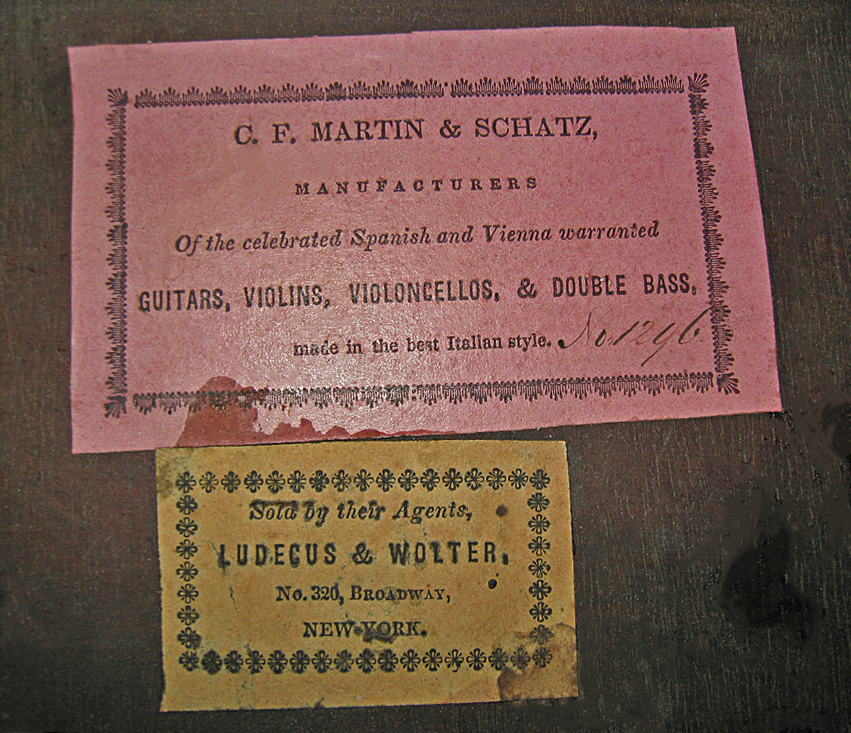
I've located Hudson Street Martins with similar labels and the following
numbers:
No. 1114 C. F. Martin Museum. Raised ivory fingerboard
& neck, tapered fretboard
No. 1160 Private Collection. Flat ebony fingerboard,
round end fretboard
No. 1168 Sold by Gruhn Guitars, Nashville. Raised
ivory fingerboard, tapered fretboard
No. 1173 Fred Oster, Vintage Instruments, Philadelphia. Flat
ebony fingerboard, round end fretboard
No. 1176 Illustrated above, Raised ebony fingerboard, round end
fretboard
No. 1188 Metropolitan Museum of Art, New York. Raised ebony
fingerboard, tapered fretboard
No. 1296 Martin
& Schatz illustrated above, Raised ivory fingerboard, square end
fretboard
In the 1840's Martin teamed with John Coupa, who sold guitars with the
"Martin & Coupa" label.
Martin Coupa label with the "John F. Nunns" store stamp and
Coupa's Chestnut Street address attached:
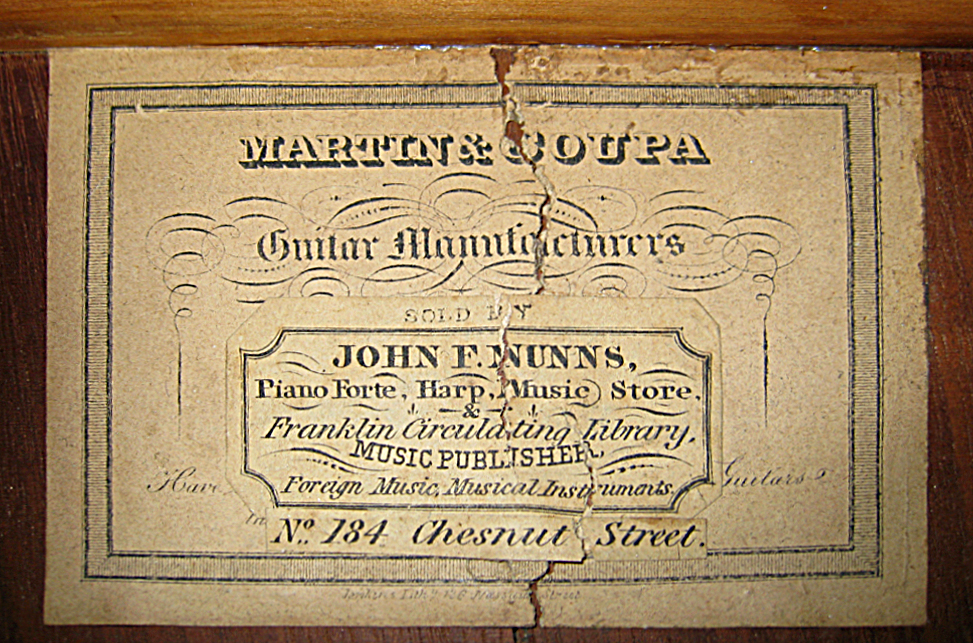
The original Martin & Coupa label:
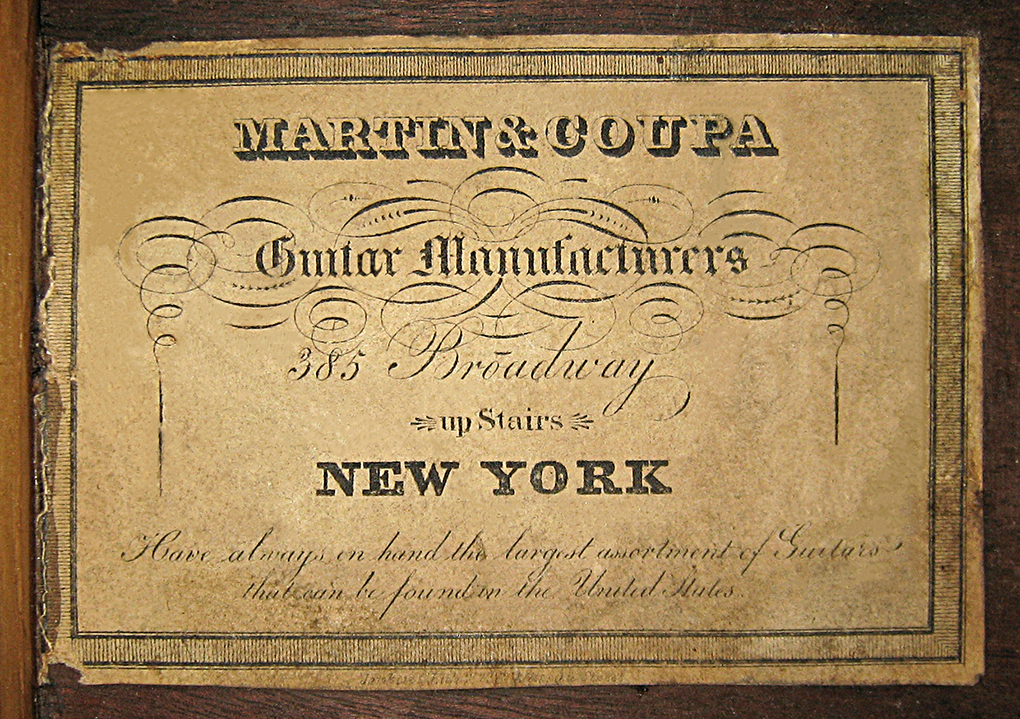
This label appeared in a small number of zithers built for P.
H. Louis Brachet of Philadelphia in the 1880's.
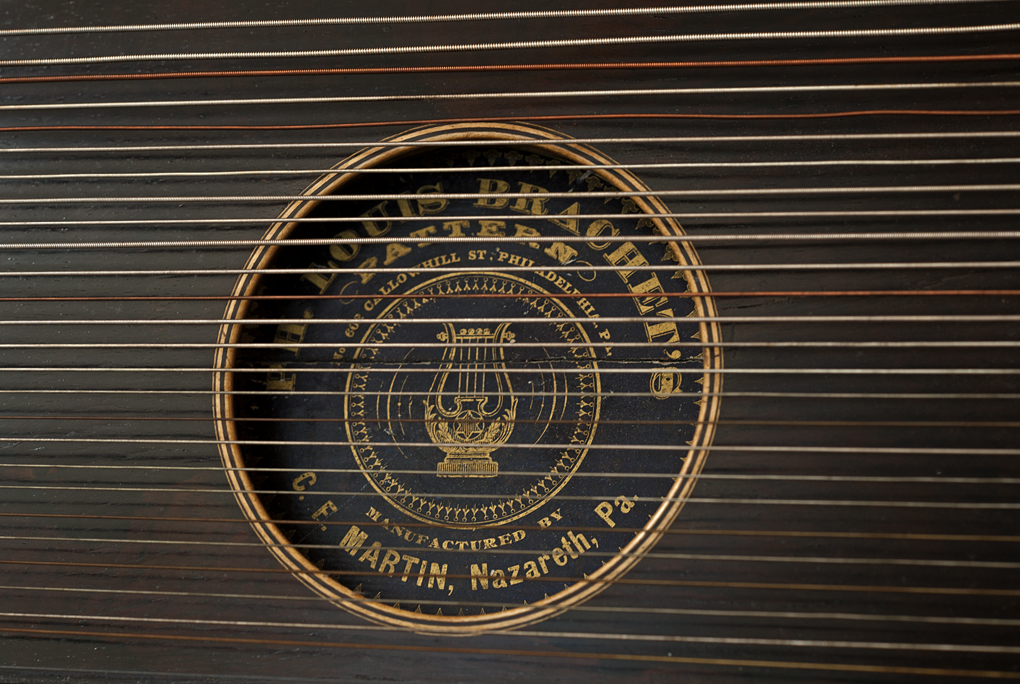
The "M. Nunes & Sons, Royal Hawaiian" label appears on some Hawaiian
Guitars made for the Southern California Music Company to appeal to the
Hawaiian market, while other SoCal models sport the "Rolando" label.
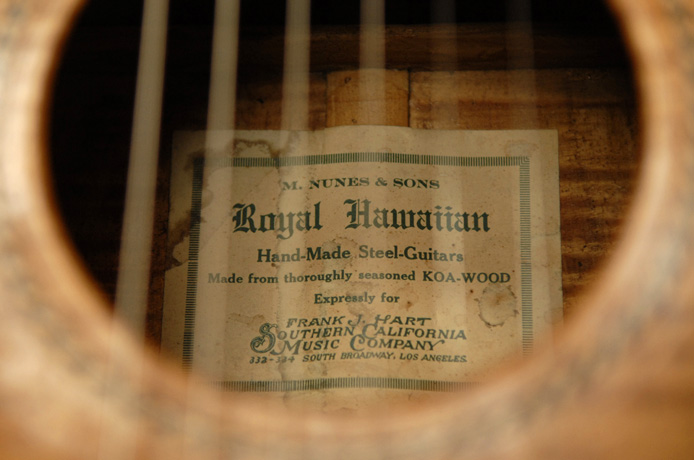
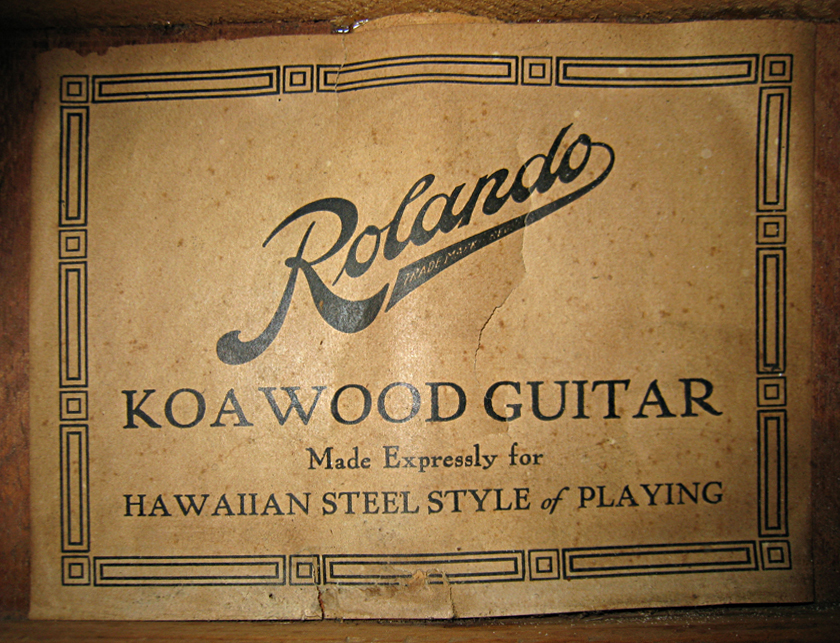
The S.S. Stewart Label appears on 2-17
Special Guitars Produced for Buegeleisen &
Jacobson in 1923
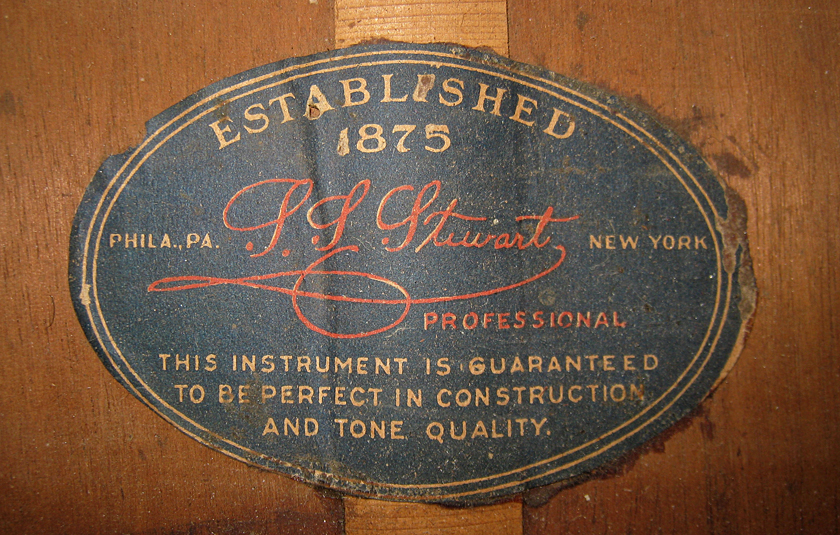
The Tiple is a ukulele size instrument with double strings
that was developed for the Wm. Smith Company in New York in 1921.
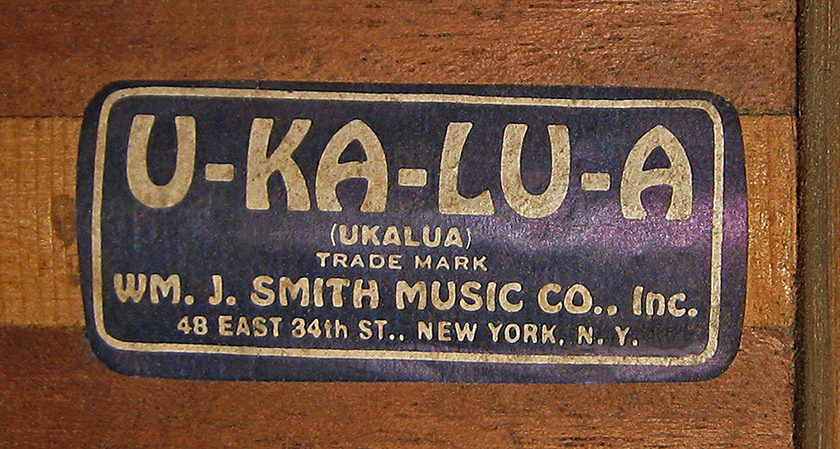
Headstock Stamps and Decals
Most 19th Century Martin Guitars
have "C.F. Martin New York" stamped on the back of their headstocks,
as Martins were still distributed from New York even after Martin
moved from New York to Pennsylvania.
Numerous examples have been seen with holes drilled in the headstock,
which were thought to be the result of unsophisticated owners who had
clumsily defaced these beautiful guitars. In fact, these holes
were drilled in the headstocks of early Martins by Mr. Martin himself,
for ribbons attached for hanging, following the tradition of the Spanish
headstocks these emulated.

Once Martin began distributing
their guitars directly from Nazareth in 1898, the stamp was changed to
"C.F. Martin & Co, Nazareth, PA".
This 1896 Martin 0-42 has a "Nazareth, PA", which is unusual for
a pre-1898 Martin.
During much of the 19th century, Martins with tuning pegs also had a
pegs made of ivory or horn on the back of the headstock for hanging.
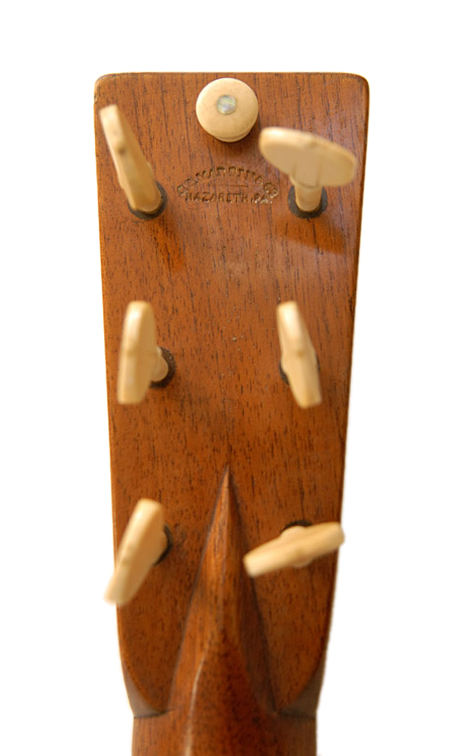
Early Martin guitars were made for
classical
playing and, traditionally, classical guitars were made with both
headstocks and
fretboards left unadorned and
without inlay. The first Martins with headstock decoration
were 1860's and 1870's Martins with engraved silver plaques tacked
to the headstocks, inscribed with
the name of the owner.
1870's Martin 0-40
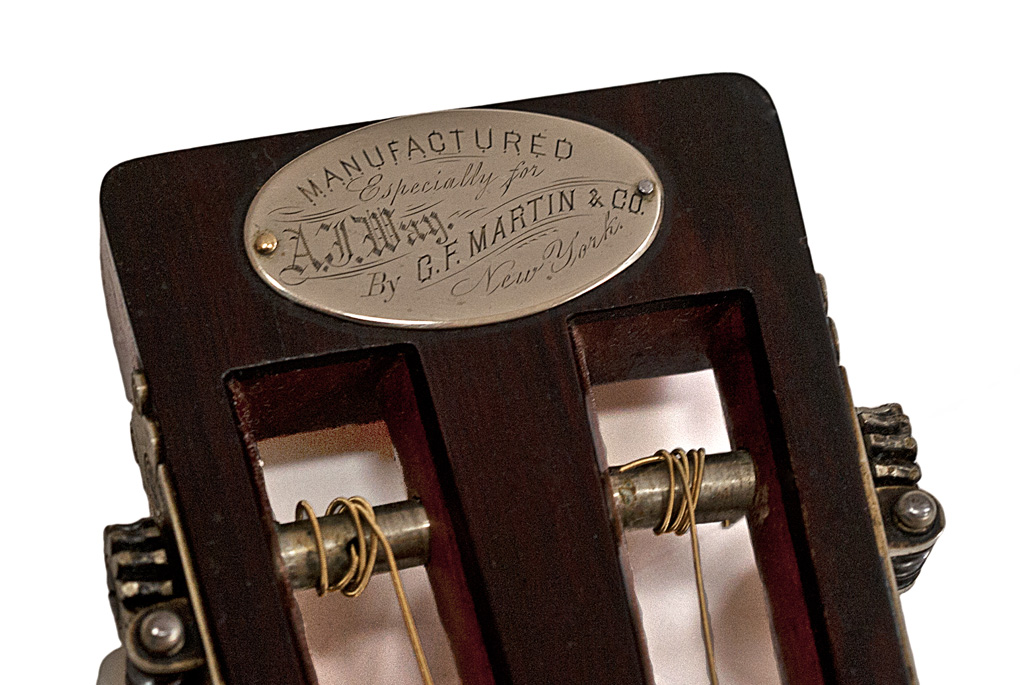
The first Martin logos appearing on the front
of some Martin headstocks in 1932 were not decals, but were printed in
gold leaf. These logos can be identified by
letters lacking
the black outline seen on the later decals.
1933 Martin 0-17
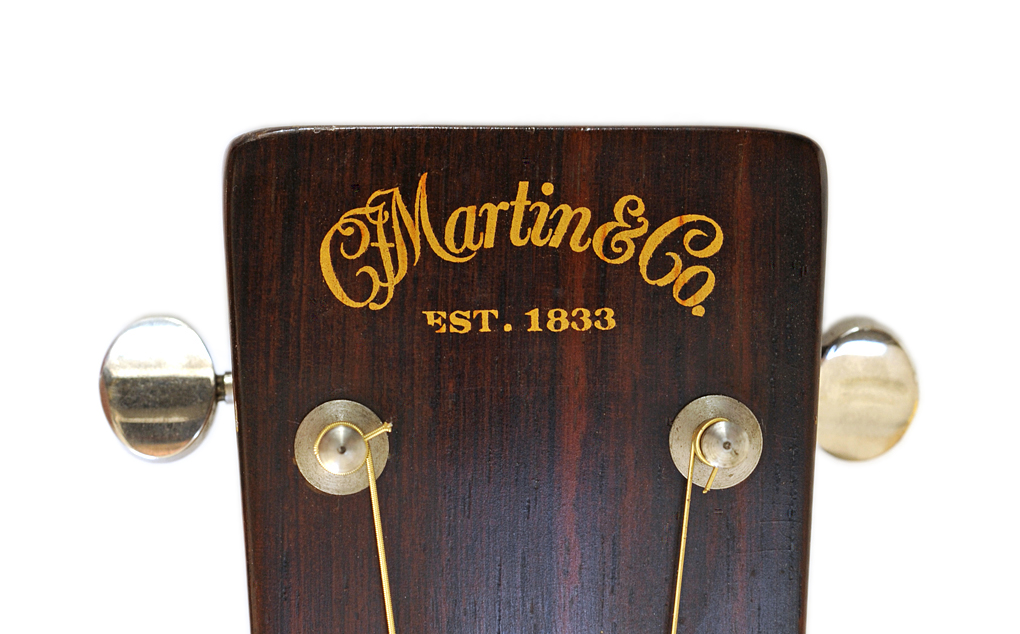
The solid gold leaf logo was replaced by a gold decal with a black
outline.
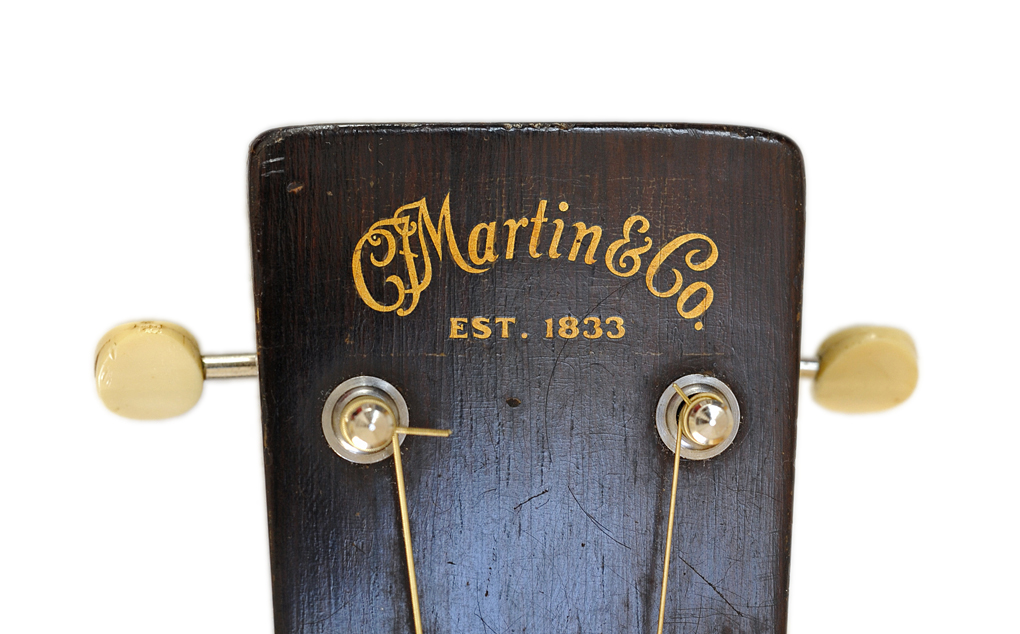
Until 1934, the front decal was used in
conjunction with the stamped logo on the back of the headstock which was
still used in this transitional period.
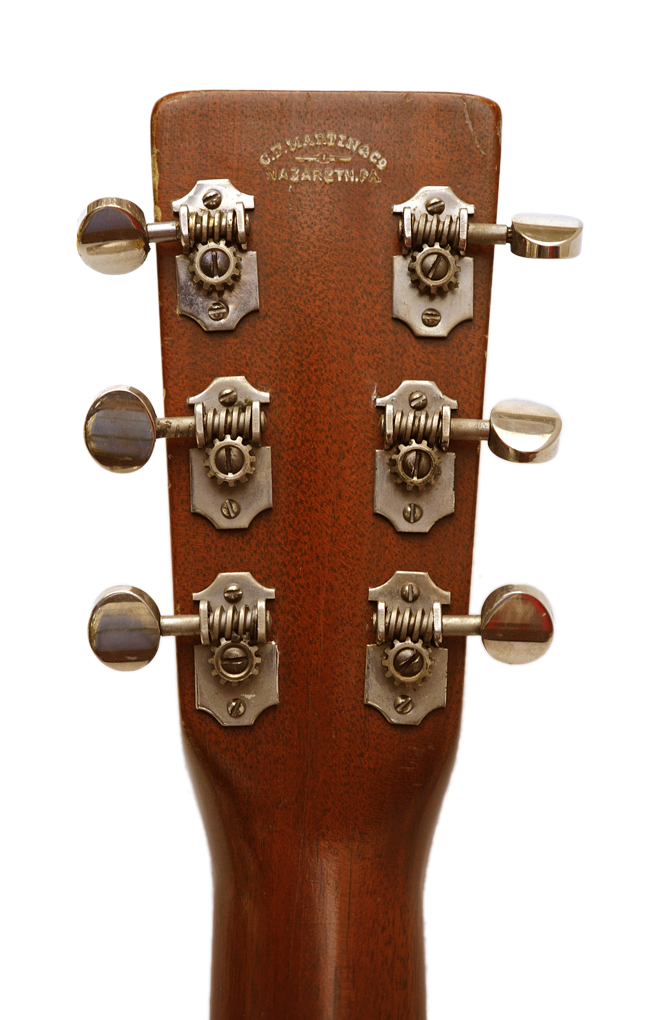
According to the revised edition of Longworth, "the second version
of the logo, with black edging, soon came in two sizes. The large size
was used on the solid headstock, while the smaller size was used on
slotted headstocks, and also on mandolin and ukulele headstocks."
Here you can see two of the same model, both from 1934, presumably the
year they changed, one with the larger, and one with the smaller logo.
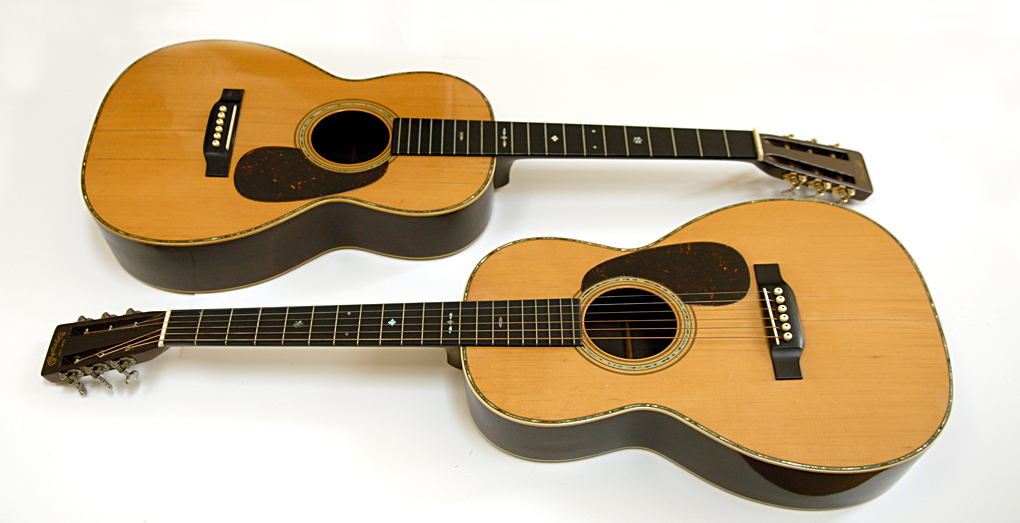
Here's the earlier, larger logo on a '34 00-40H:
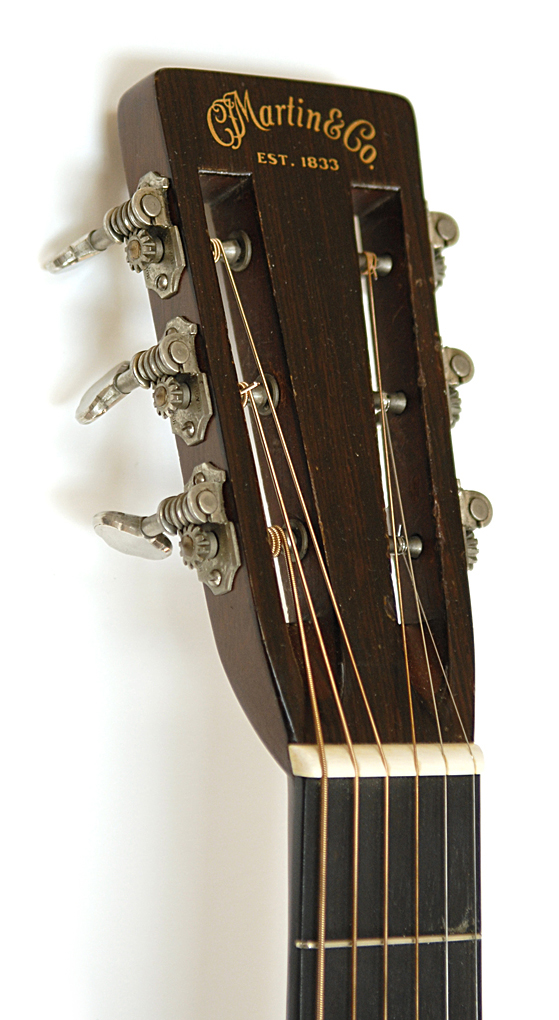
Here's the later, smaller logo on a 1962
000-28C.
Note that on the "G" and "C" Model Martins, built for gut or nylon
strings after the introduction of steels strings, Martin followed the
tradition of leaving the head plates on classical guitars blank by
placing the decal on the back side of the headstock.
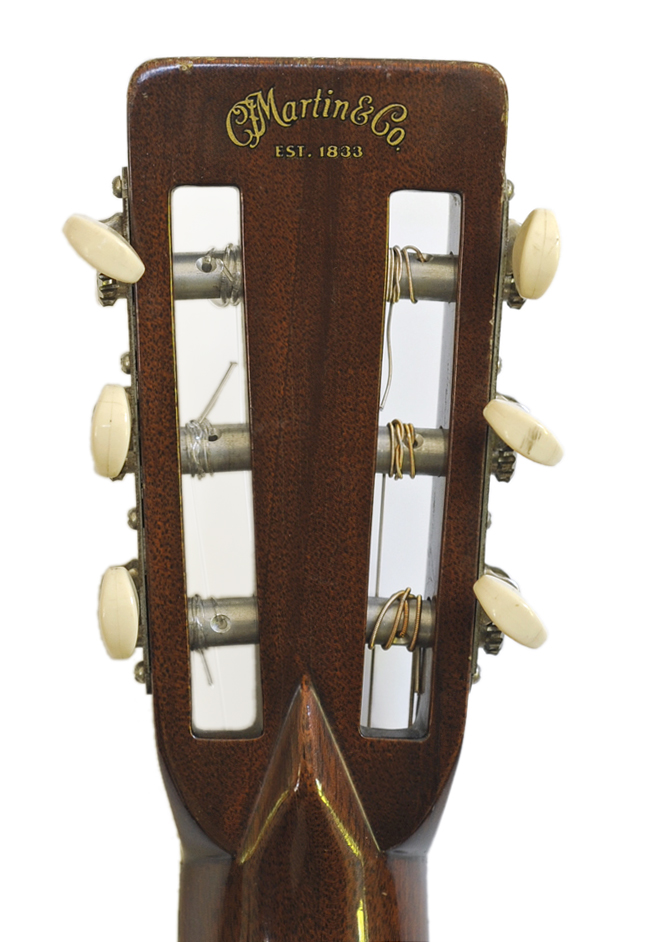
The Southern California Music Company requested that the Martin
name not appear on their early Hawaiian guitars, preferring to use the
name "Nunes", which was respected among Hawaiian players.
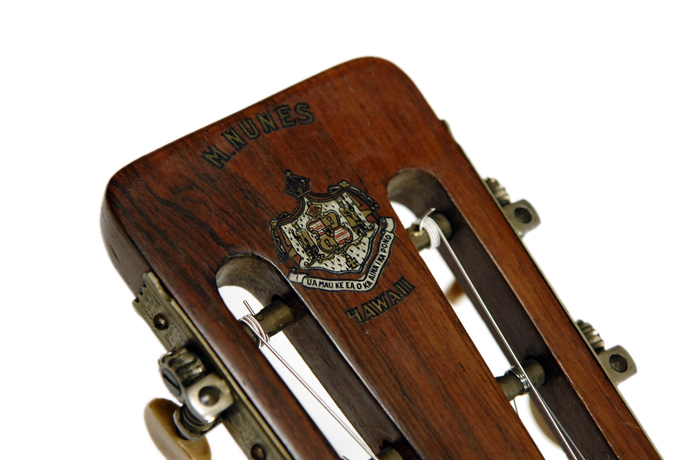
Over the years, some of their guitars had the SoCal name stamped on the
back of the headstock, some had the Martin name, some both, and some
none at all.
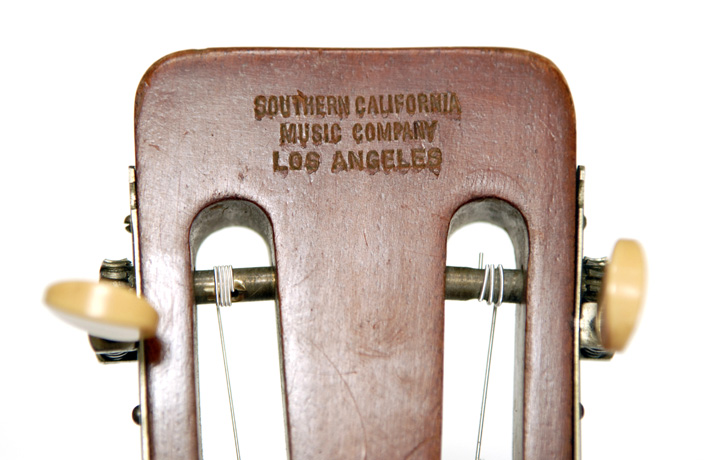
The Oliver Ditson Company had their name stamped on the back of
headstocks.
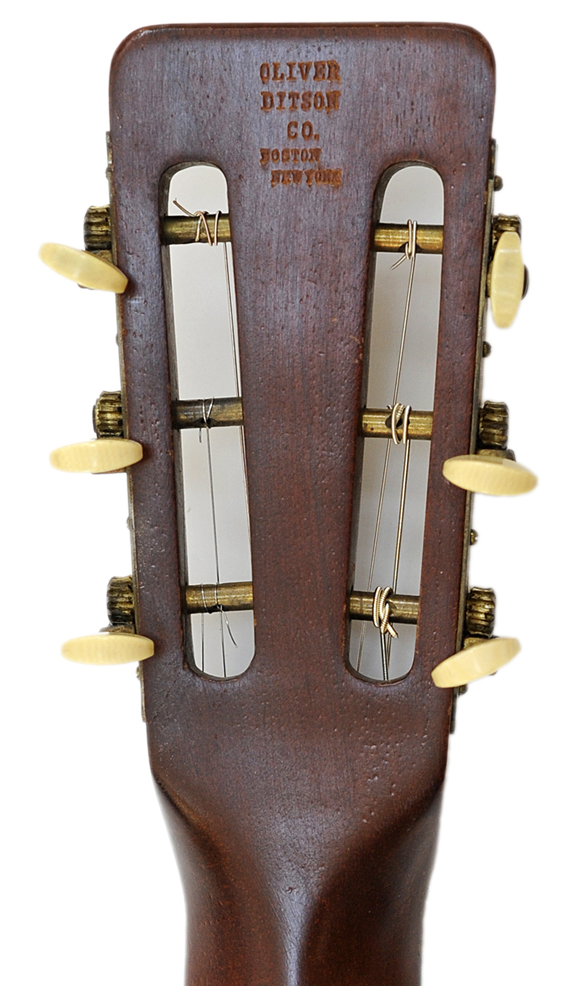
The Wurlitzer Company chose to use both their name and the Martin name
on some guitars...
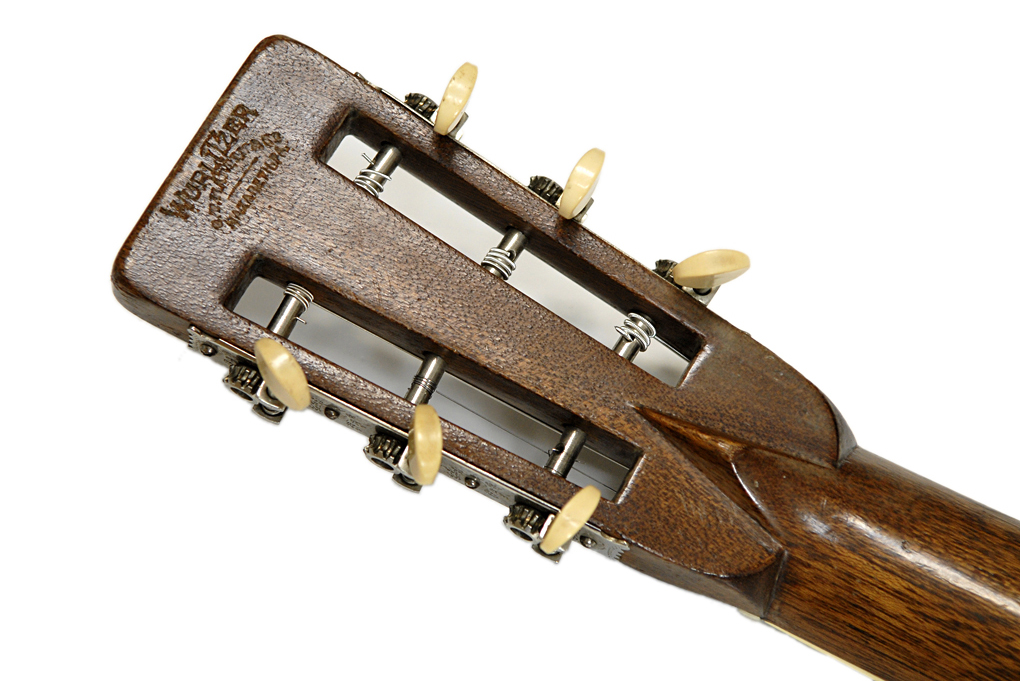
while you
will find only the Wurlitzer name on others...

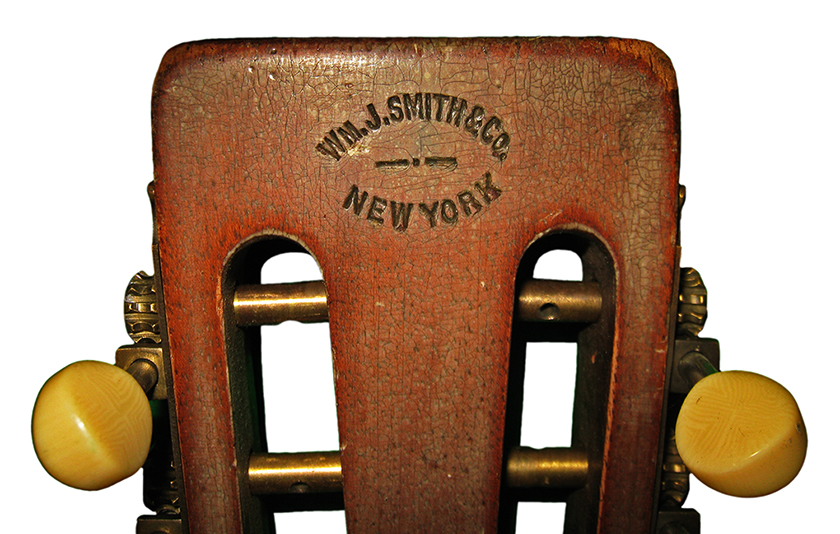
The "Paramount Style L"
produced for the William L. Lange Company was not stamped as such, but
the Paramount name appeared on a fancy inlaid headstock veneer supplied
by the Lange Company.
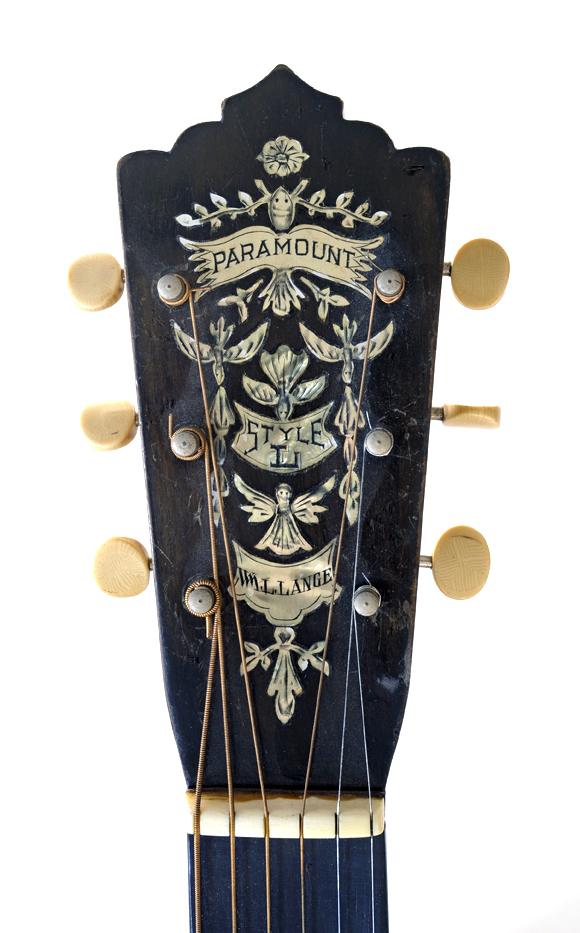
The Style 44 guitars were produced in several sizes for Vahdah
Olcott-Bickford to sell to her students, some of which carried the
"Artist Model" name,
which appears to have been hand painted.
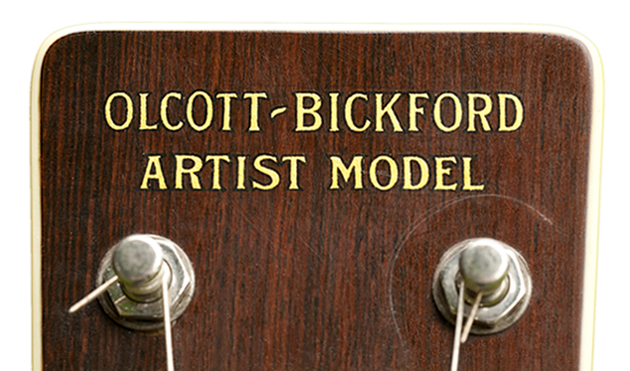
Outside Back Stamps
As you can see, the ebonized, Stauffer style headstocks of early
Martins, dressed in black, did not provide an ideal surface for the
Martin stamp.

So Martin stamped their early guitars on the back of the body near the
heel. Martin continued this practice for some time on guitars with
cedar neck with Spanish heels...
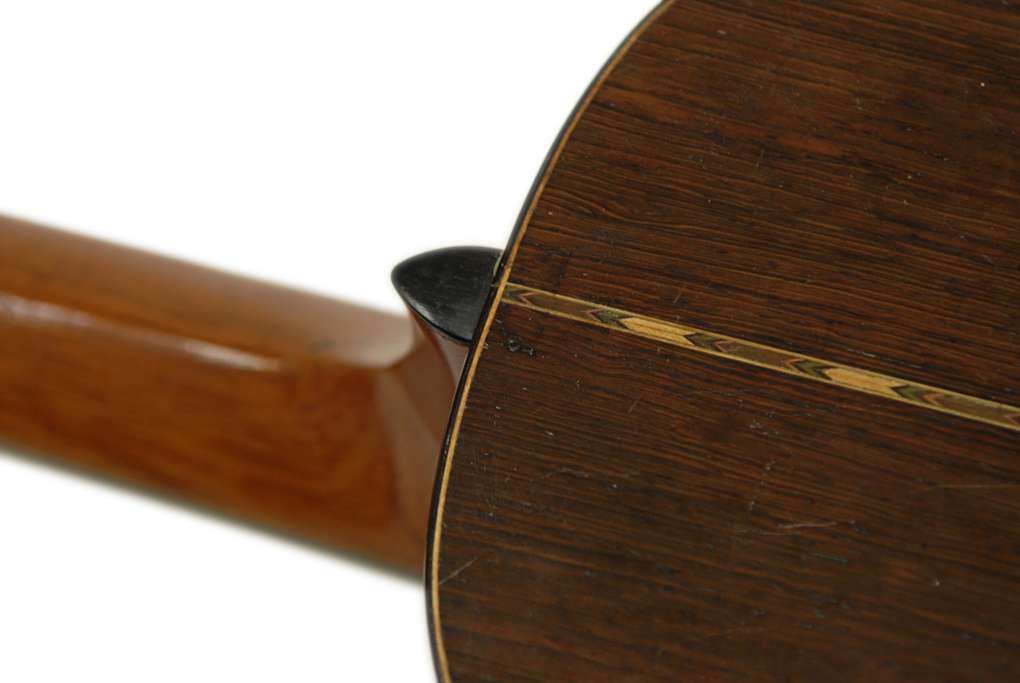
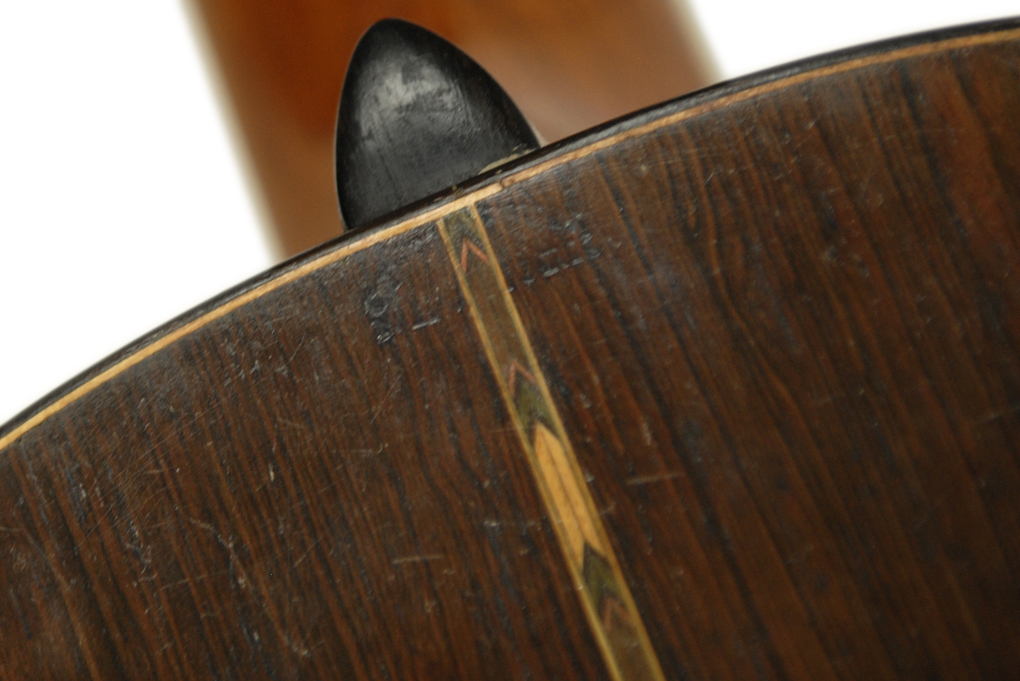
...and into the beginning of the 20th century on
guitars with the black ebonized headstocks and necks.
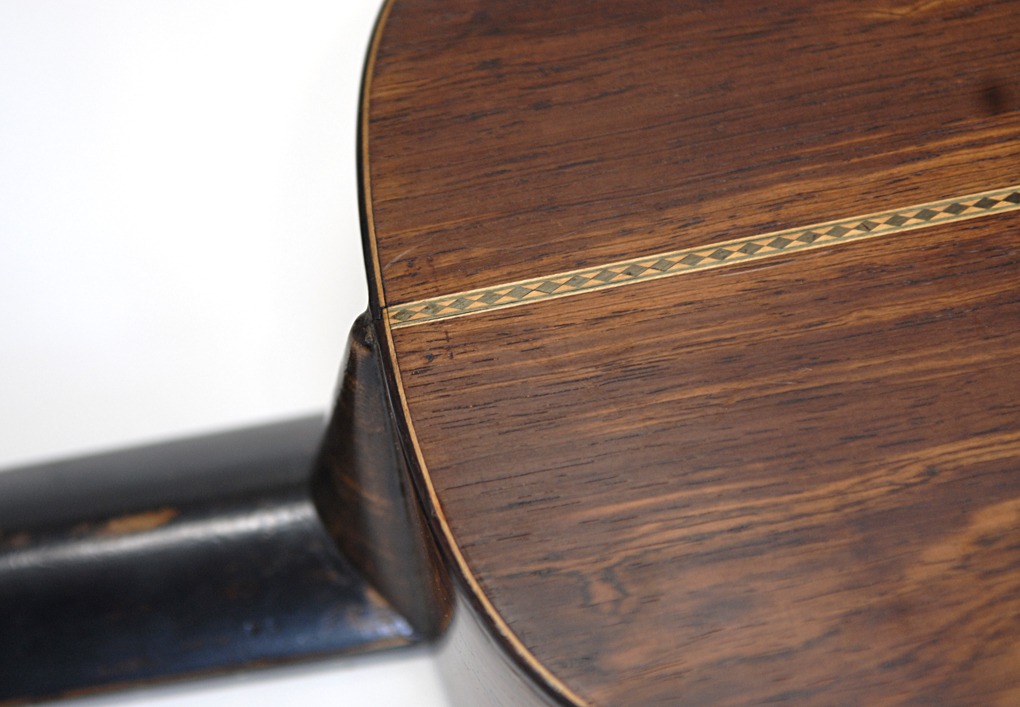
Inside Back Stamps
C.F. Martin, New York
Martin's earliest guitars are stamped "C.F.
Martin, New York" on the inside back center strip.


C.F. Martin & Co. New York
Once C.F. Martin Sr. took on his son and nephew as partners in 1867,
the inside back center strip began to read "C.F.
Martin & Co., New York". Martin
continued using the New York stamp for many years after moving to
Pennsylvania as his guitars were still distributed from New York.

C. F. Martin & Co. Nazareth, PA
After Martin's distribution arrangement in New
York ended in 1898, the inside stamp began to read "C. F. Martin &
Co. Nazareth, PA"
Note that Martin headstocks continued to
read "C.F. Martin New York" only until 1898, even after the
interior labels added "& Co.".
In other words, from 1867 until 1898, Martin headstocks read "C.F.
Martin New York", while the interior stamps read C.F.Martin & Co.
New York".

Many, but not all, of the guitars Martin made for other firms were
stamped with the names of those firms.
Foden Special

Oliver Ditson
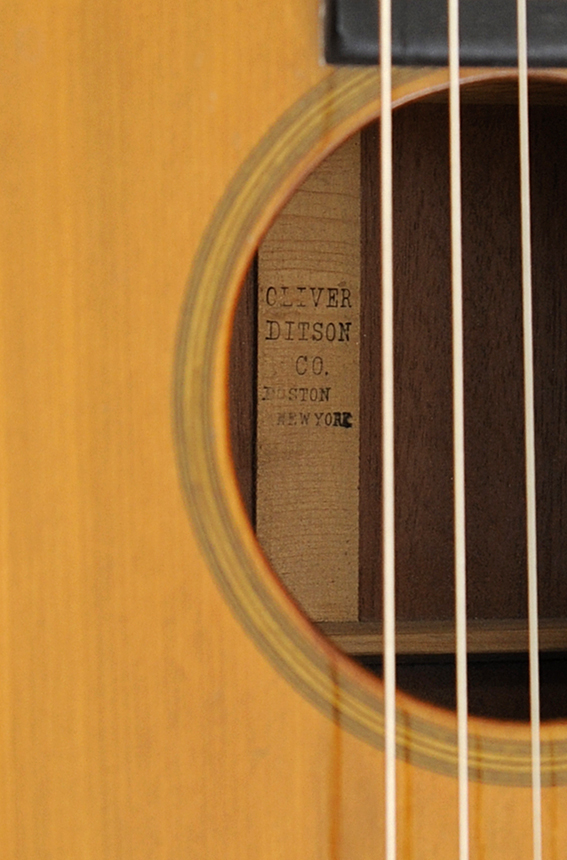
Grinnell Wolverine

Southern California Music Company
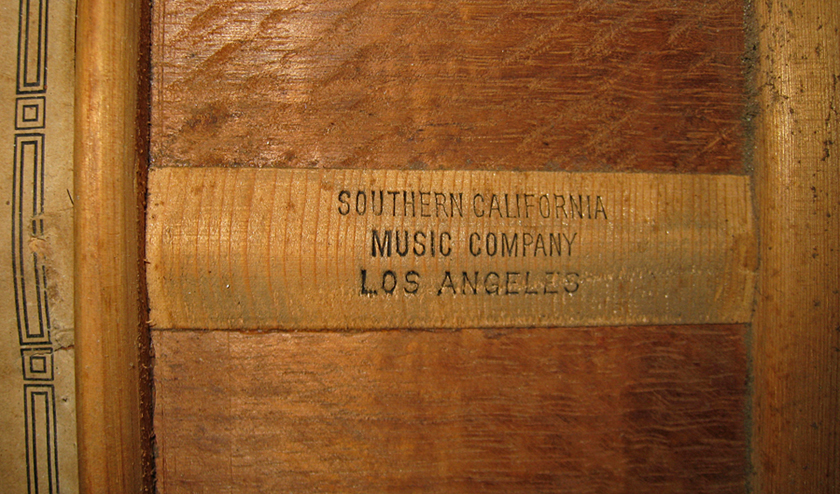
S.S. Stewart
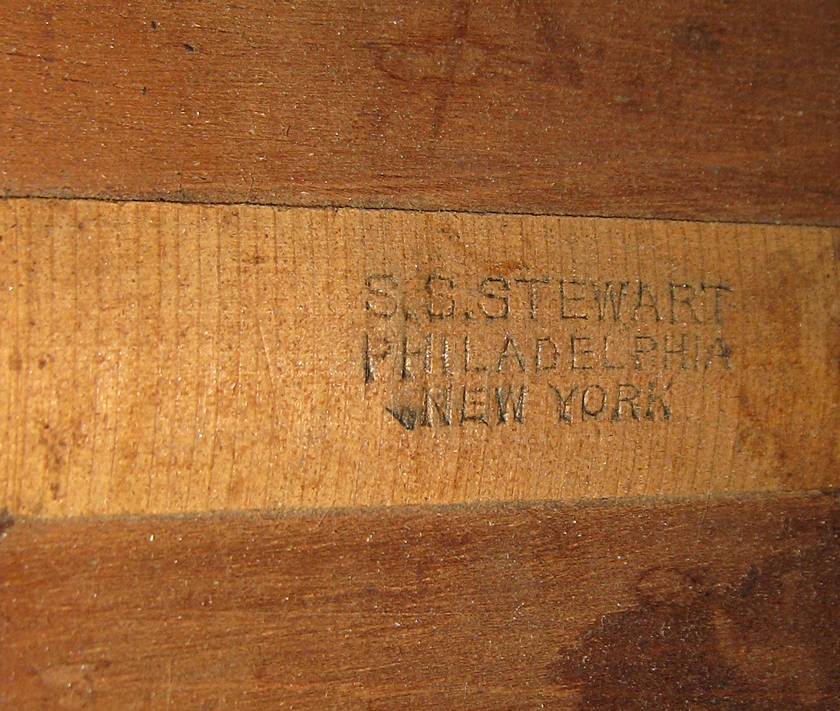
Briggs Special Mandolin
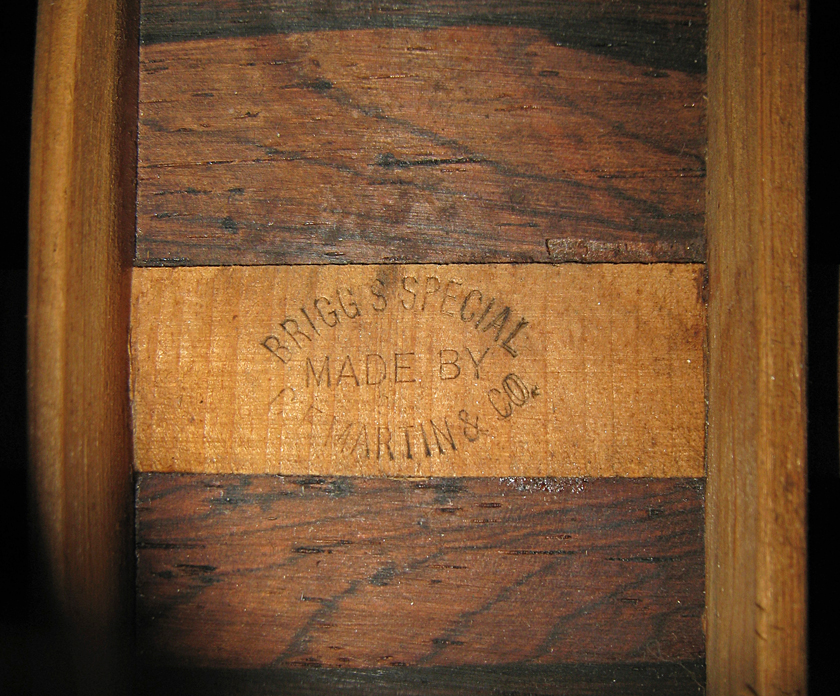
Neck Block Stamps

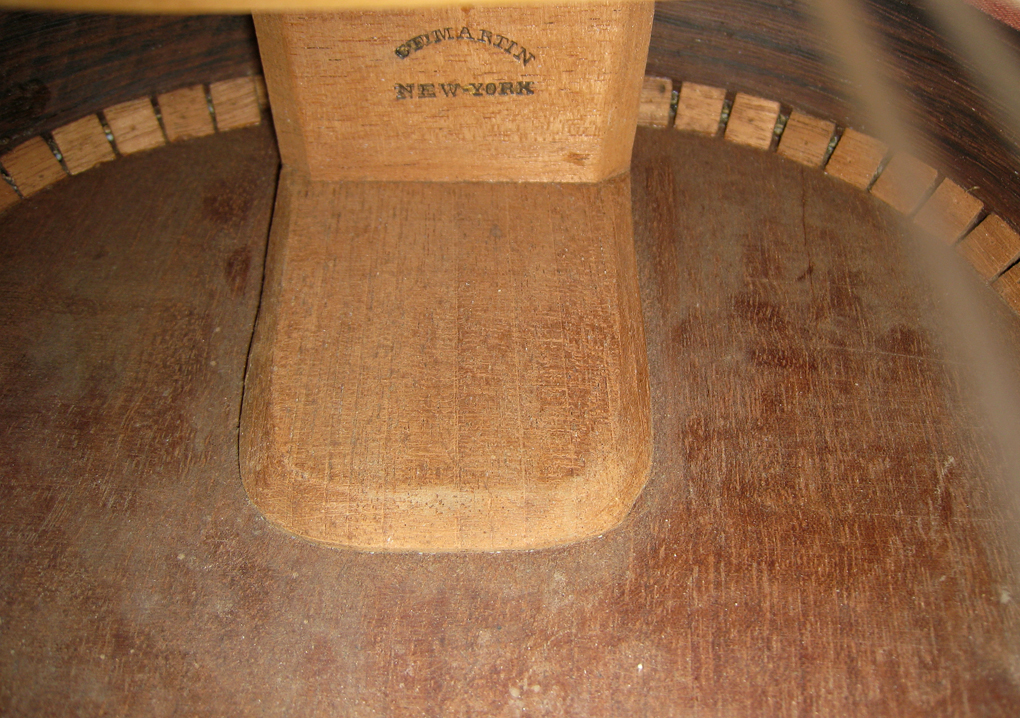
With the exception of a few early examples with the Spanish foot, such
as
the one above, all of the neck block stamps I've seen on Martins
from the very earliest to this example built in March, 1889 are upside
down.
March, 1889 Martin 2-34
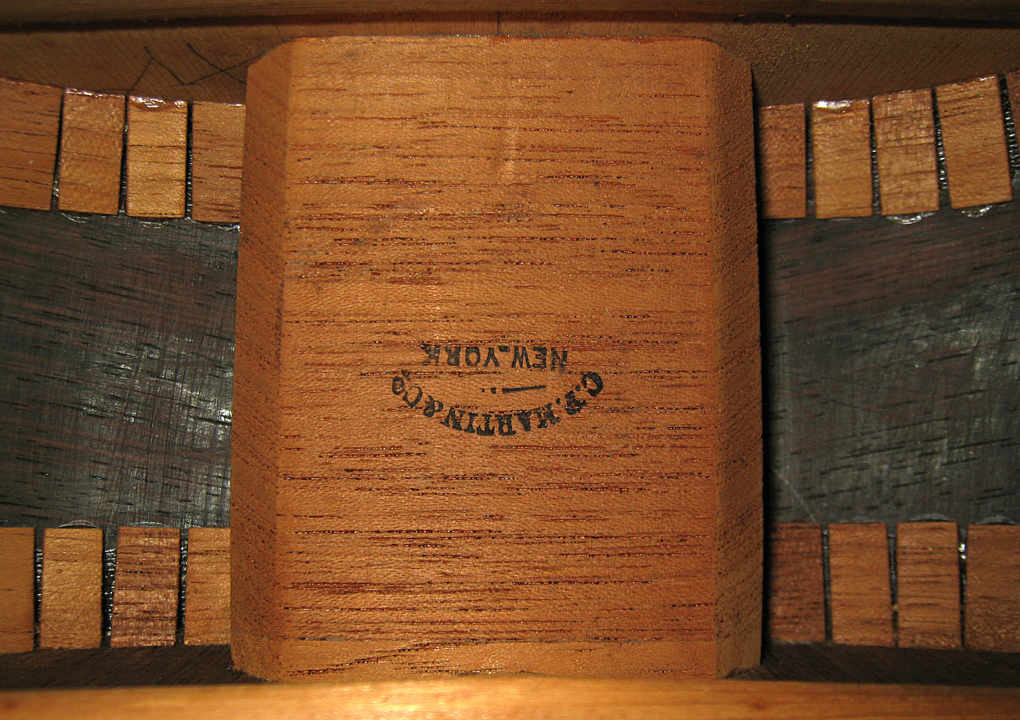
All of the later neck block stamps read
right side up. The earliest example I've seen was stamped
"2/90".
This narrows the date of change from sometime between March,
1889 and February, 1890.
February, 1893 Martin 2 1/2 - 17
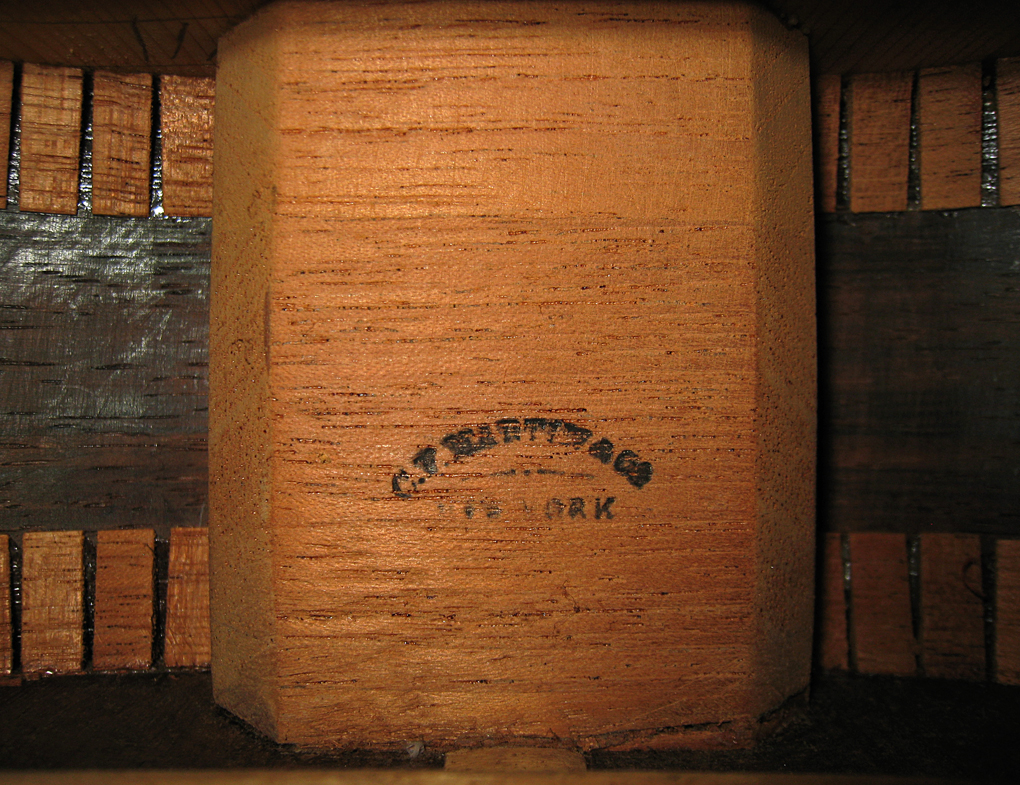
The Foden Special is one of the few Martins with a unique neck block
stamp made for a specific dealer.

Serial Number Stamps
In 1898 Martin began assigning serial numbers to their guitars, starting
with the number 8000, estimating the number of guitars produced to date.
Serial numbers, along with the new Nazareth, PA stamp, were imprinted on
the neck block.
1898 Martin 1-21
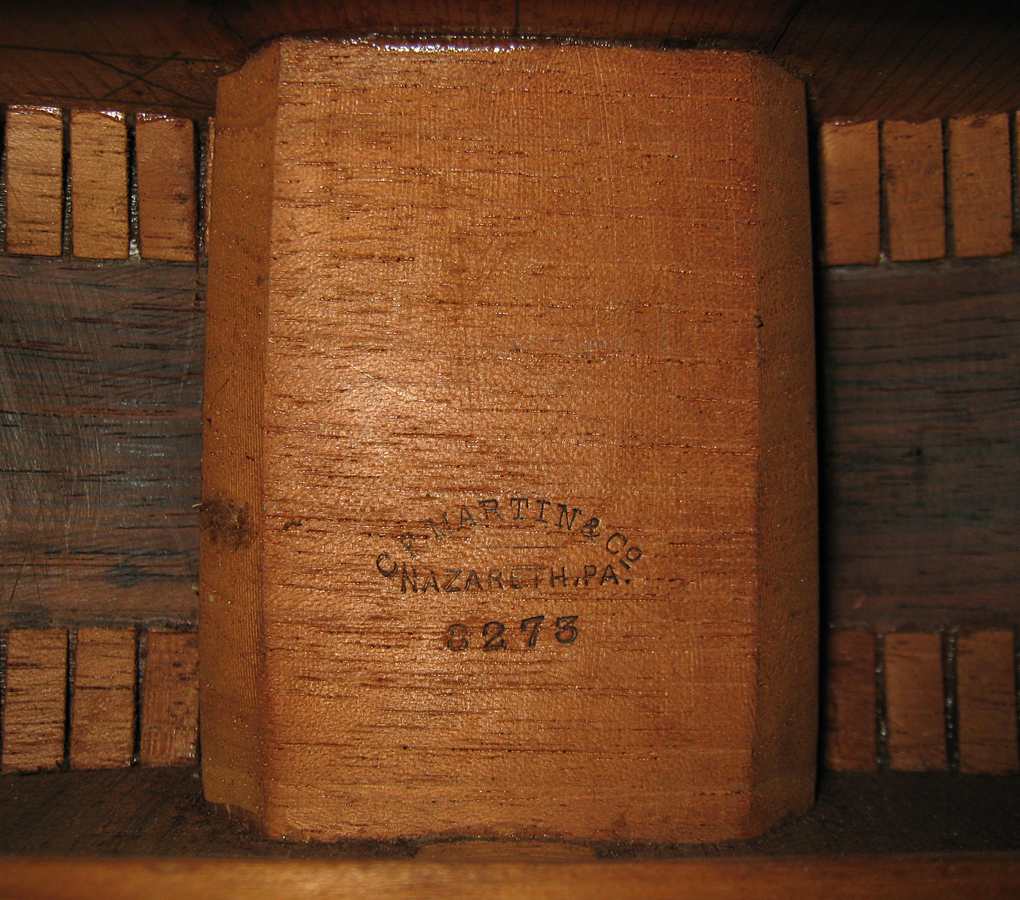
For a short period of time, in 1899, Martin also stamped the serial
number on the end of the headstock:
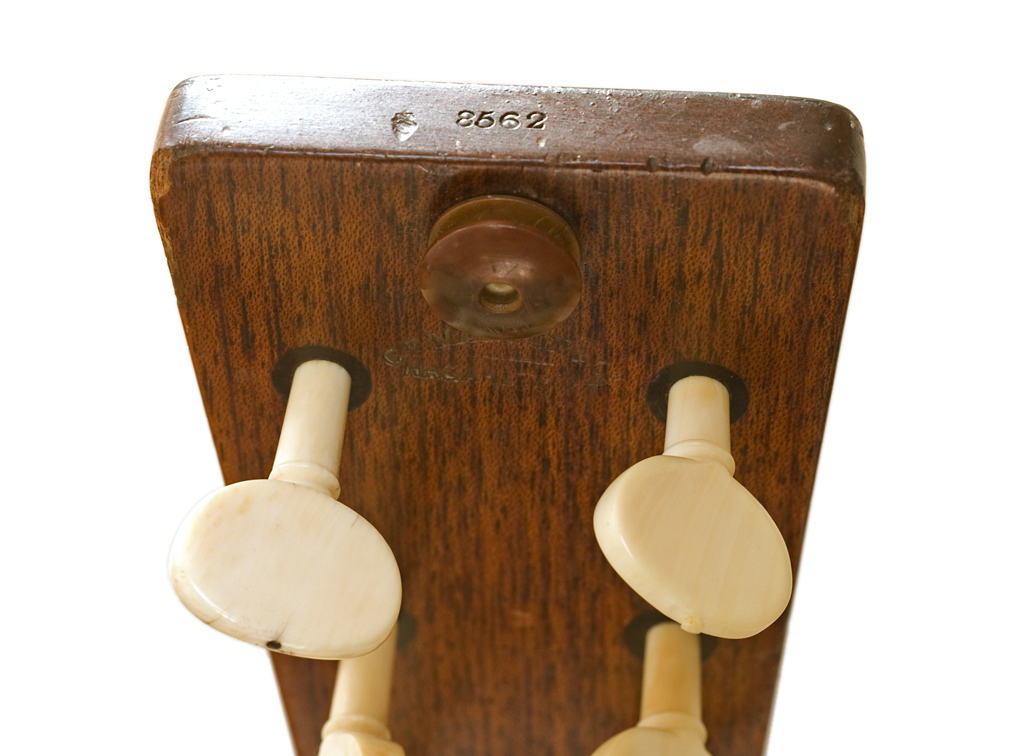
In 1918, Martin was still stamping the Nazareth Address on the neck
blocks.
1918 000-42
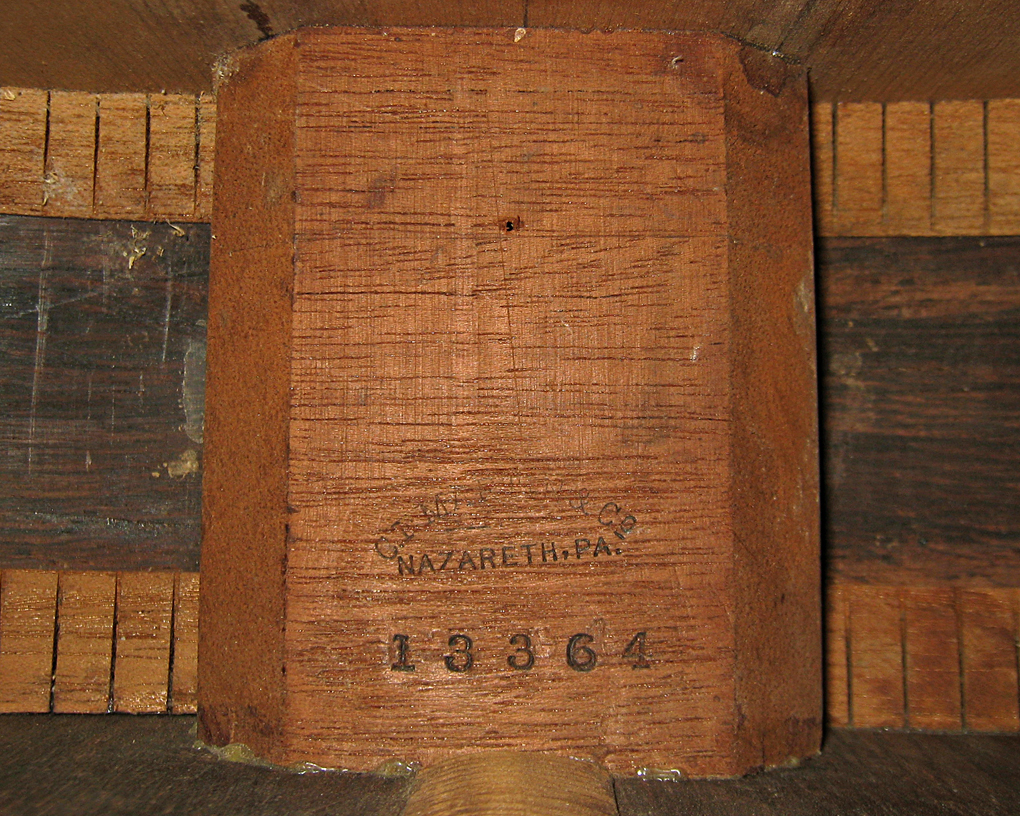
By 1919, when the company was struggling to keep up with production,
Martin began stamping the serial number only.
1919 Martin 0-45
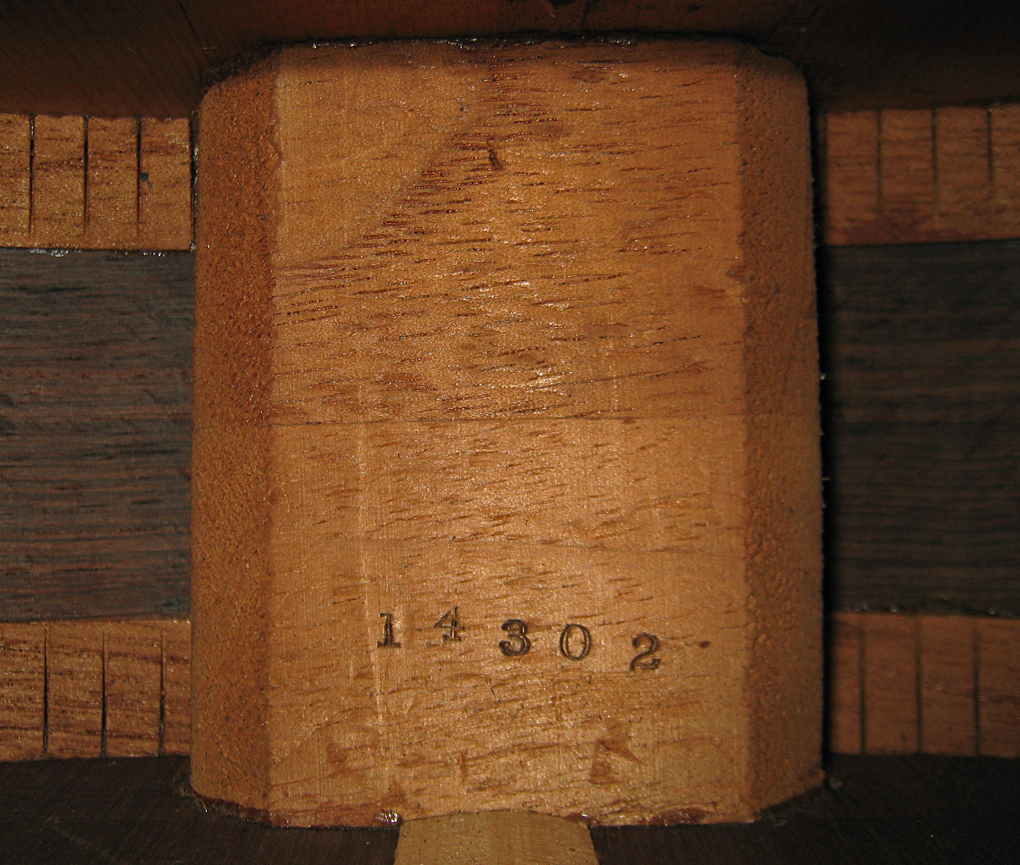
Beginning in 1930, Martin also stamped the model number on the neck
block.
Apparently, Martin began stamping the Model name on the neck block near
the beginning of October, 1930.
1930 Martin OM-45 Deluxe, stamped 9/23/30
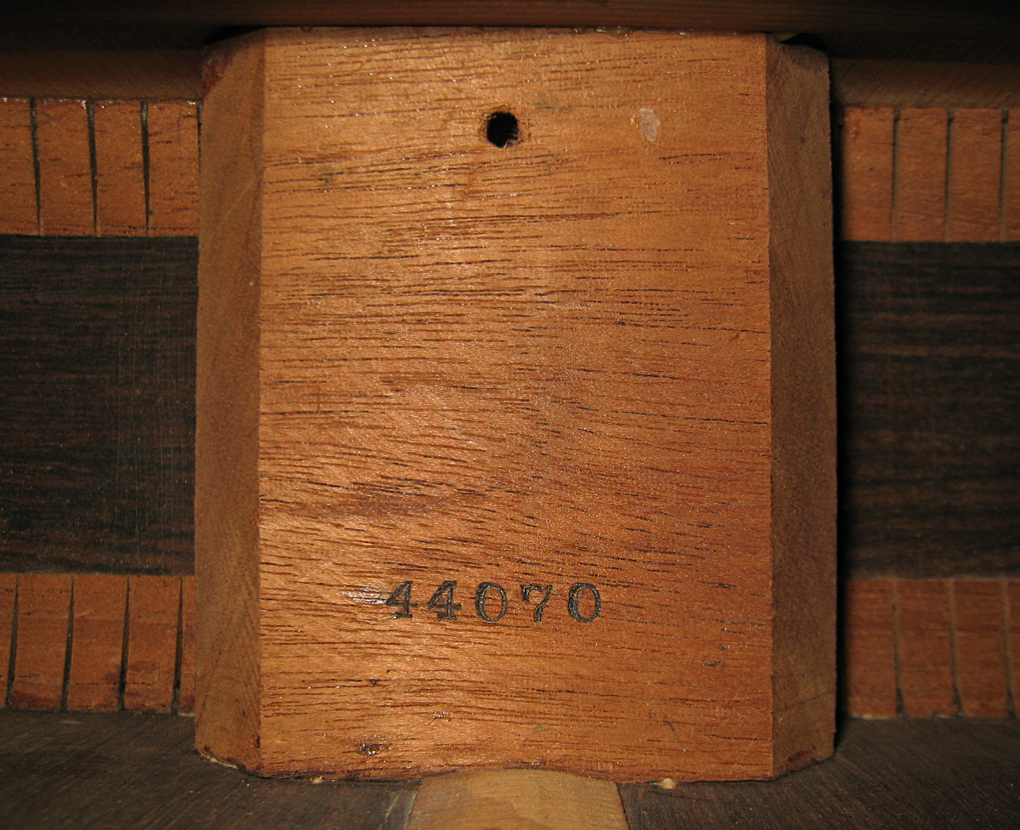
1930 Martin OM-18P
Stamped 10/24/30
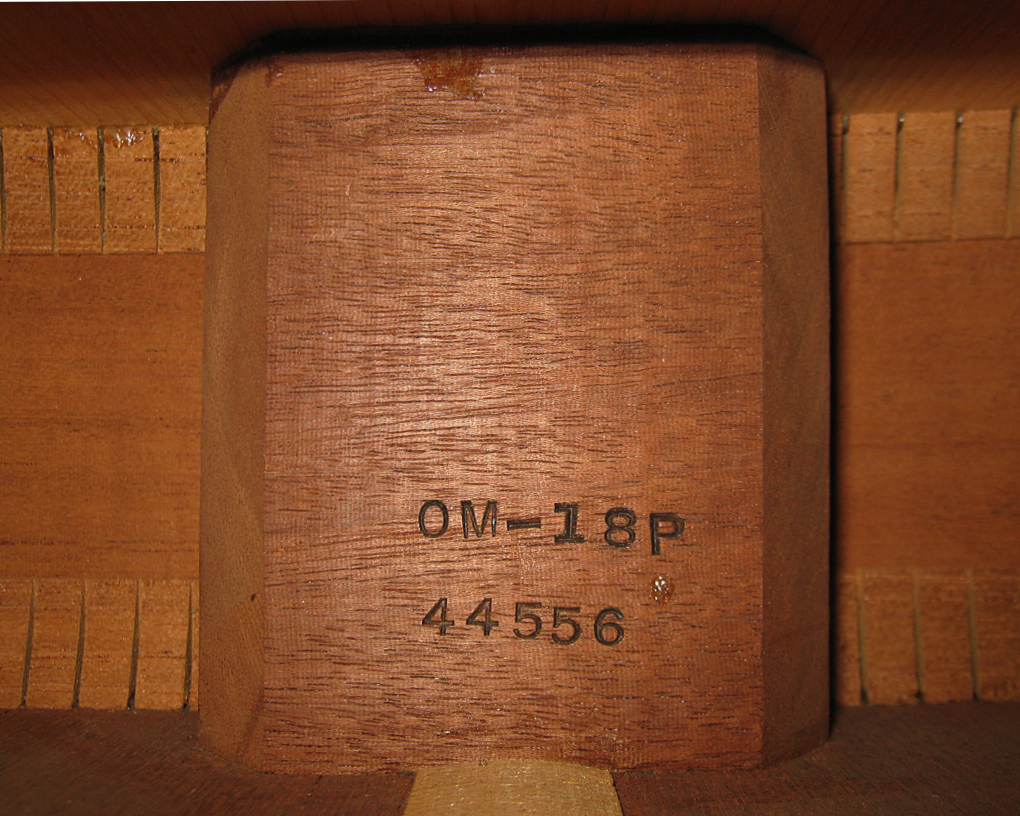
Signatures
Many, but not all, Martin guitars built between the 1870's and the
second decade of the 20th century are dated in pencil on the underside
of the top. The format varies greatly, with some initialed by F.H.
Martin or a shop foreman, some containing the day and month, and some
showing the year only.
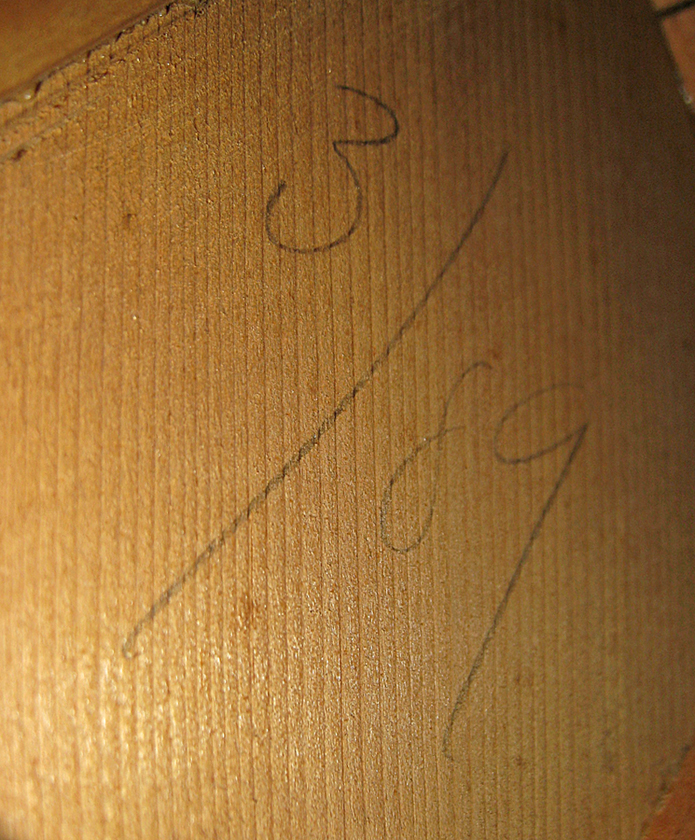
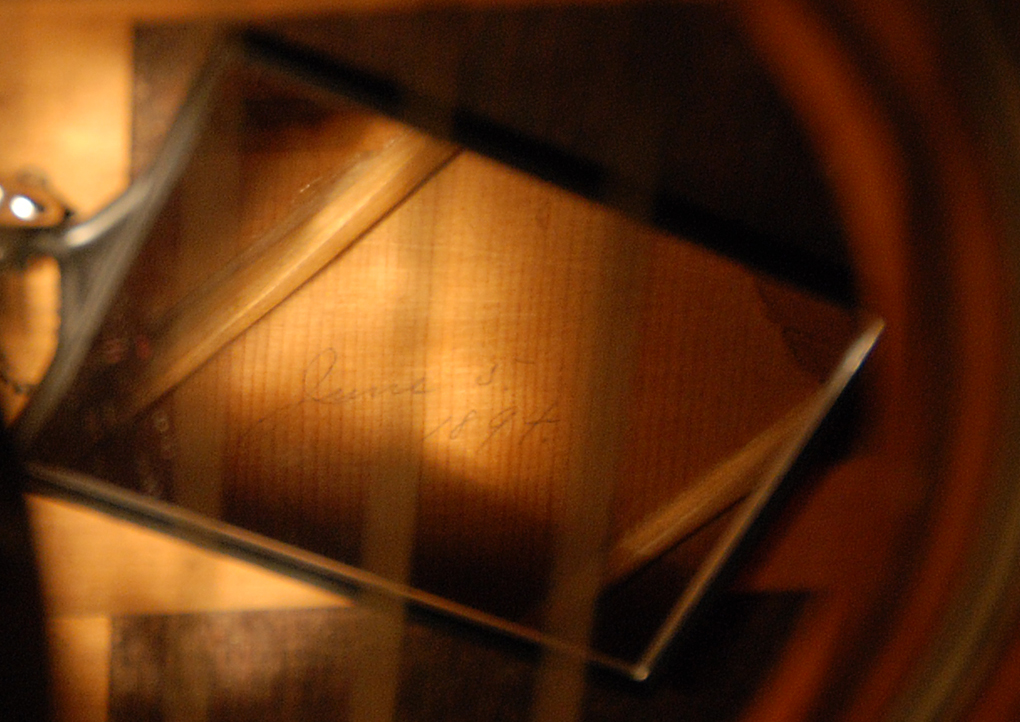
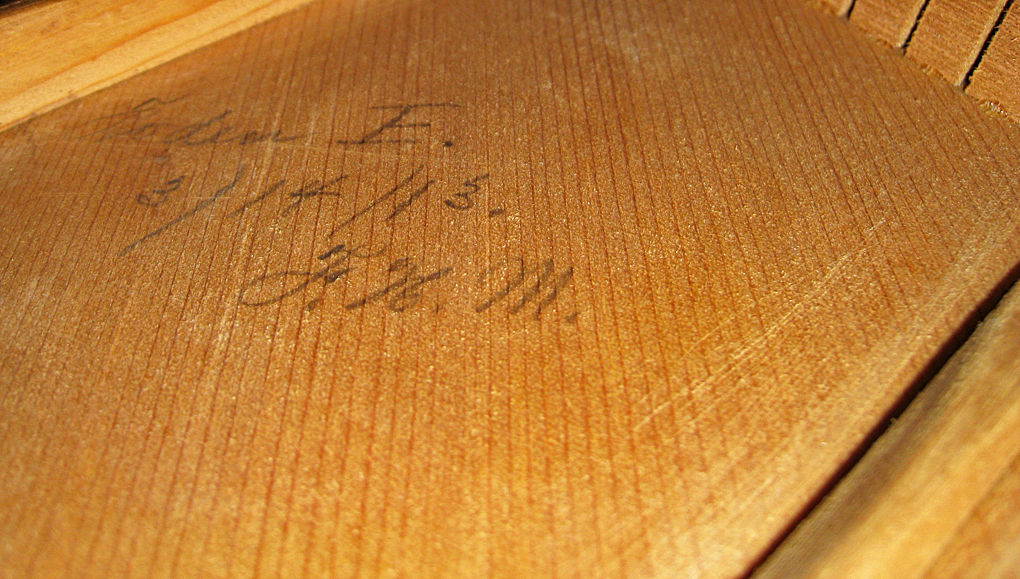
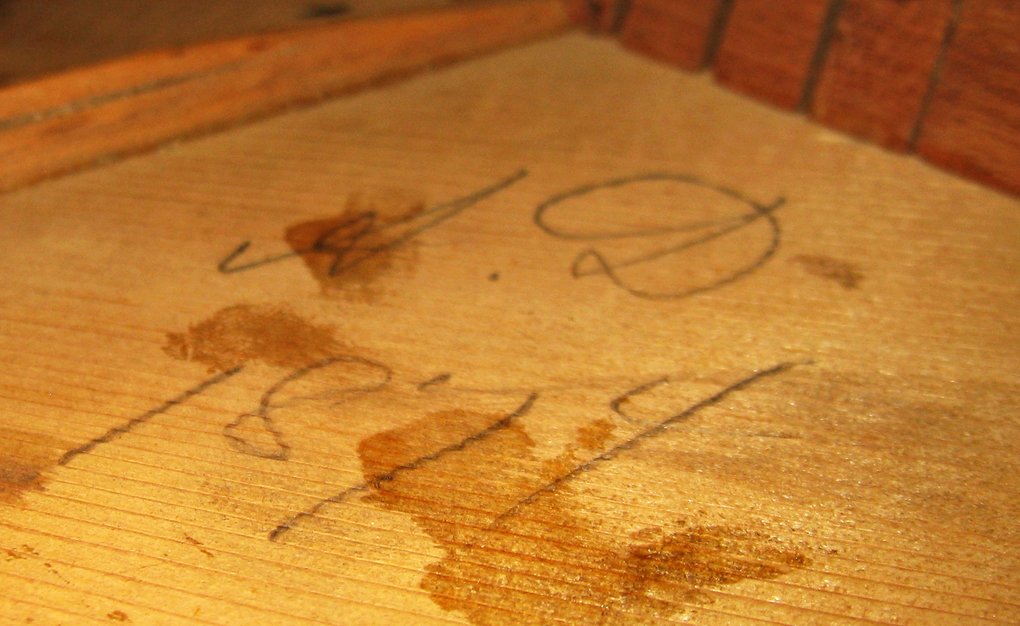
Repair signature
The guitar below is a rare example of an instrument with a repair that
was documented, in this case by shop foreman John Deichmann, the creator
of the Dreadnaught, the Orchestra Model, and a number of Martin's other
greatest achievements.
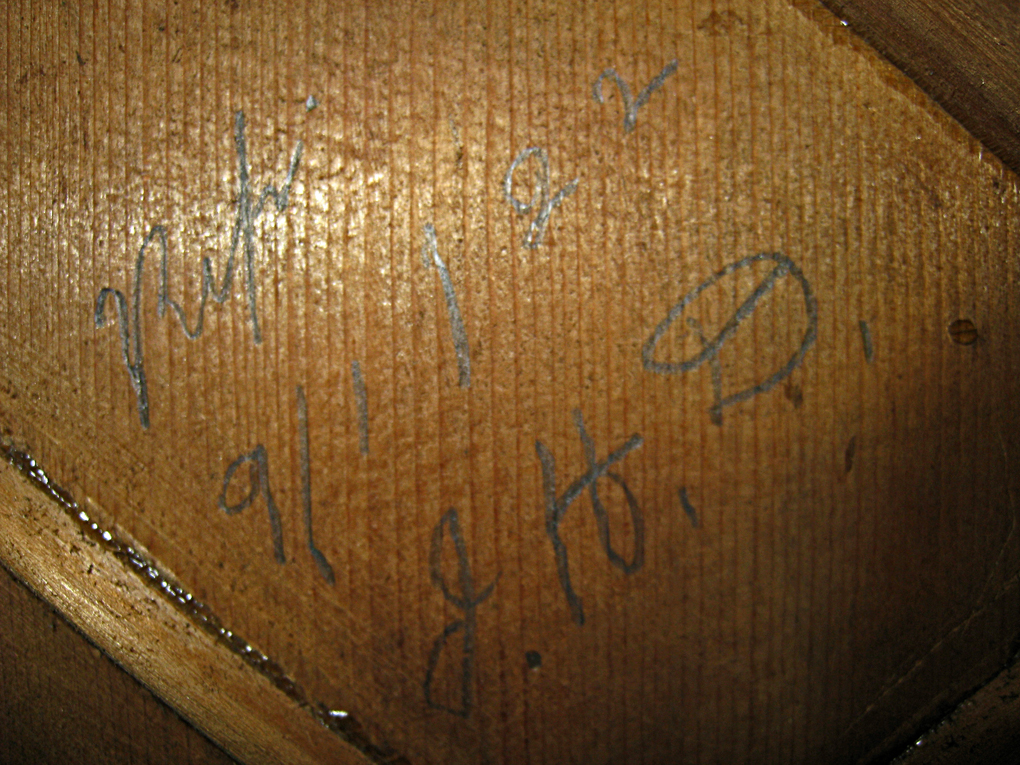
Case Labels
Martin used a number of various labels in their
cases, with minor differences in typefaces and design.
This is the very first Martin label to appear, showing up in 1867, the
year Martin incorporated.
No labels were made for Martins in coffin cases before incorporation was
signified with "& Co." affixed to the Martin name.
The earliest labels appear to be cut by hand with irregular edges and
borders, and measure roughly 1 5/16" x 1 5/8".
1860's 1-21
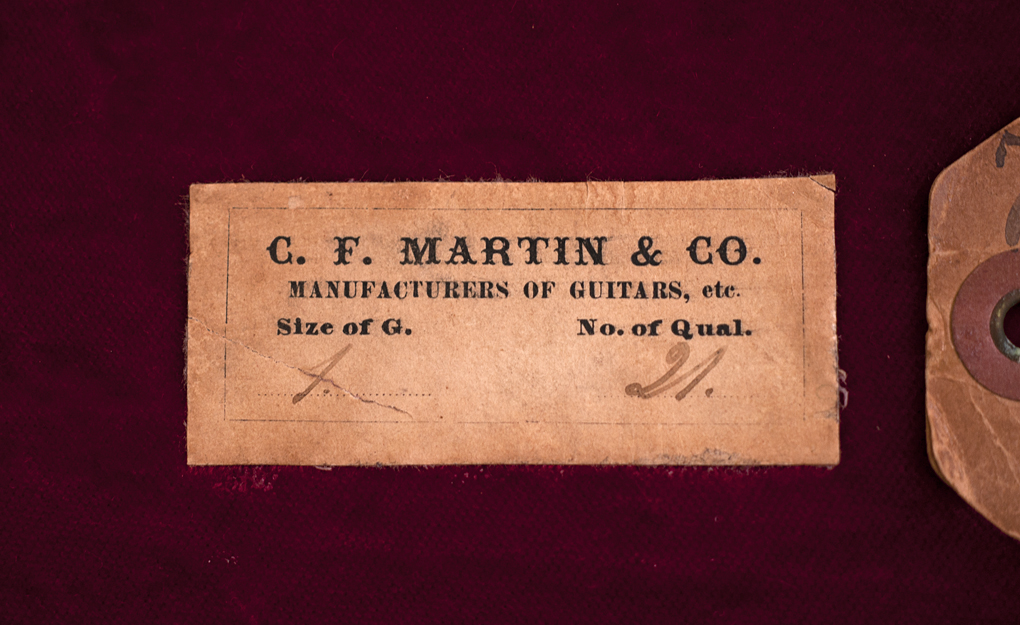
This similar looking label appears in the 1870s, with the same
information, but a simpler typeface, with bold horizontal serifs and
lacking the fancy ornamentation in the mid line of the letters, and
using a noticeably less bold type style for the "size" and "quality".
1870's 1-26

The larger Martin labels measure roughly 2" x 2 3/4".
This style, with care instructions, appears in the late 1880's.
1888 2 1/2 -24
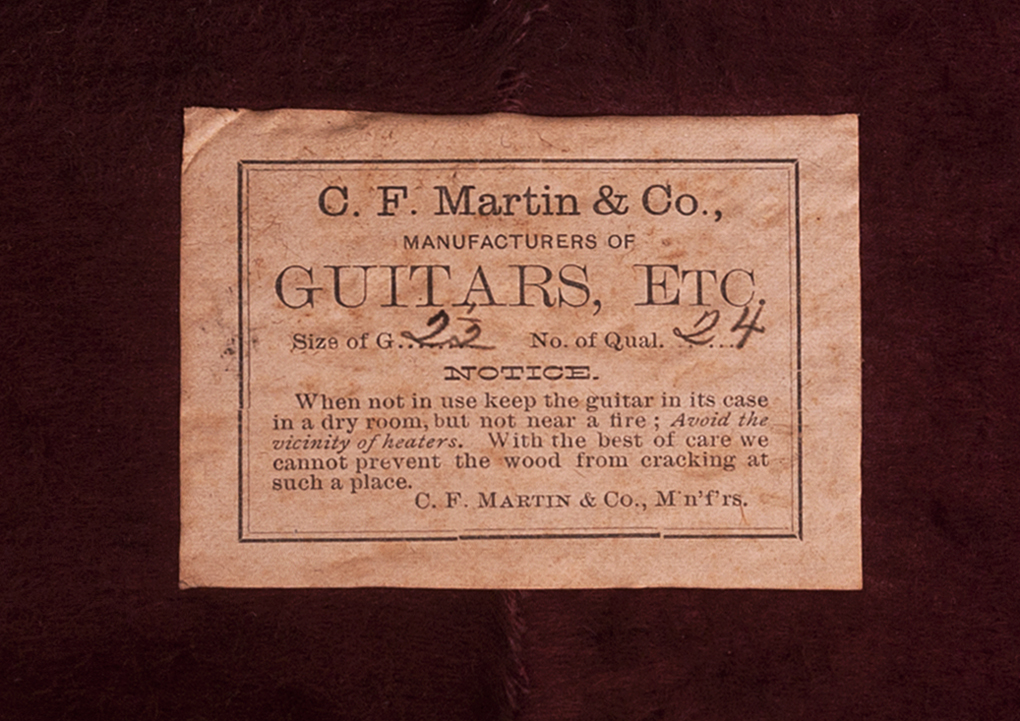
This label was common in the 1890's.
1893 2 -1/2 17
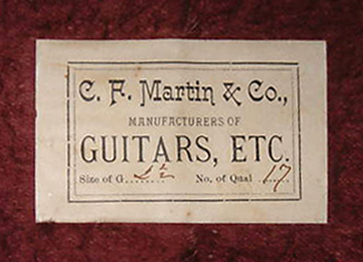
This last label, for Martin "Guitars and Mandolins", must have been the
last Martin label to appear, as Martin only began to sell mandolins in
1895. By 1899, Martin was selling two thirds as many mandolins as
guitars, so it is understandable that Martin would begin to give
mandolins equal billing on their labels.
1890's 0-28
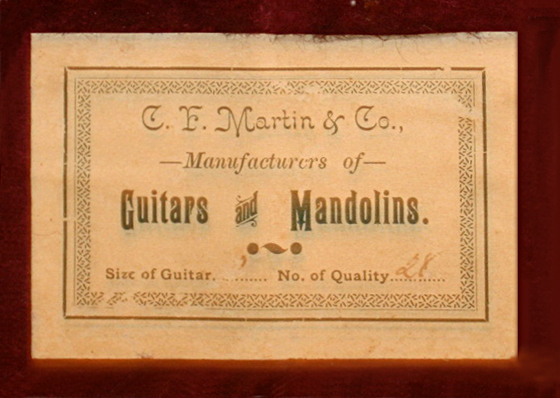
vintagemartin.com
To See Robert Corwin's Classic Photography of Folk and
Roots Musicians, visit:
For Information on
Photography for
Exhibition, Publication, CD's,
Promotion, Web Pages, Tour Books,
to Purchase Photographic
Prints, or
If You Have Questions or
Suggestions About This Web Site or Vintage Martin Guitars:
e-mail: Robert
Corwin
entire site copyright ©1998 through
2018 Robert Corwin/Photo-Arts. All rights reserved.
























